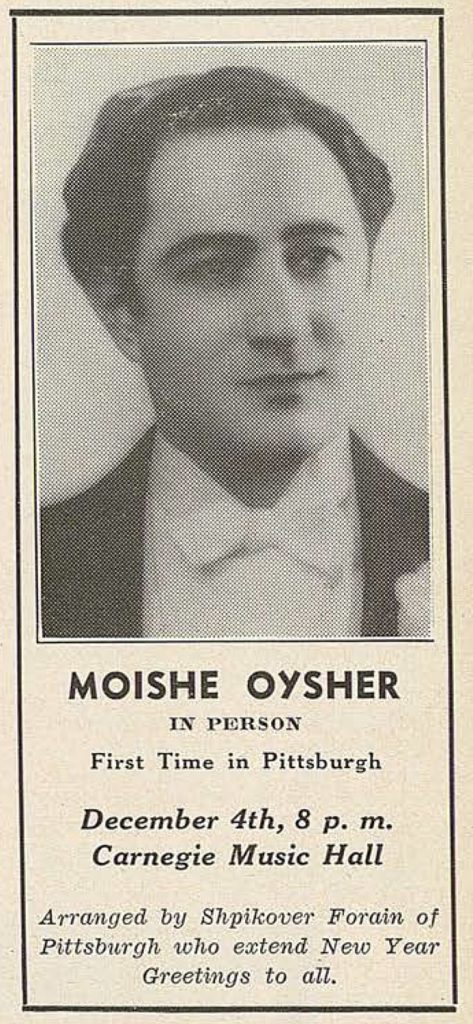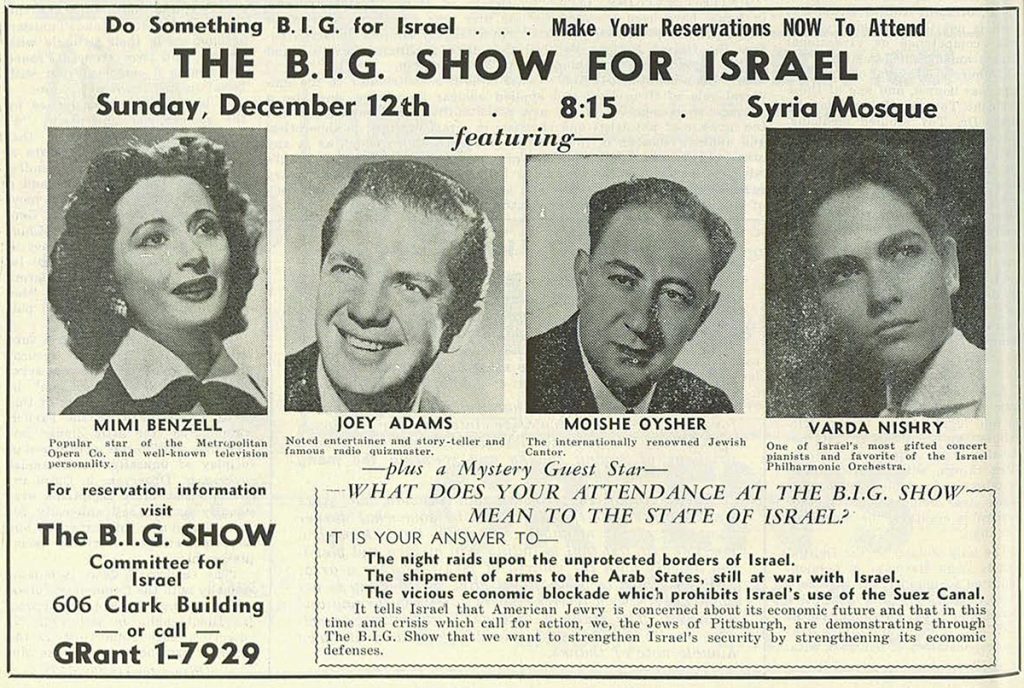Like many cities in the Western Hemisphere, the Jewish population of Pittsburgh enjoyed the Yiddish theatre tradition. Theaters throughout the city were hosting Yiddish productions by the late 1800s, and Pittsburgh was one of the few American cities outside New York with a theater dedicated entirely to Yiddish productions. The popularity of the art form declined in Pittsburgh in the 1940s, but the stars of the Yiddish stage continued to hold appeal and significance for a segment of the Jewish population. Yiddish theatre artists were celebrities in the diasporic Jewish community, blending the old world and the new. Artists connected directly to this community through a language and art form that was uniquely theirs.
Among the prominent figures during this period of transition was Moishe Oysher. Oysher was born in 1907 into a long line of chazans (cantors) and emigrated to Canada when he was 14. As a child he was enamored with the stage and the Yiddish players that traveled through his hometown of Lipkon, Bessarabia (now Lipcani, Romania) and attempted to sign himself onto troupes as a child actor several times.[1] Actor Wolf Shumsky helped Oysher break into the Winnipeg Yiddish theatre circuit, where he acted for three seasons before moving to the Montreal Yiddish Theater and joining the Canadian Actors’ Union in 1924. By 1928, Oysher was acting in the U.S., on stage as well as radio, and joined the New York Actors’ Union in 1931. Notably, Oysher created his own Yiddish theatre company in 1932 that toured through Argentina, Uruguay, and Brazil.[2]
After returning to New York, he signed on to chazan for the High Holidays at the First Romanian-American Congregation in Manhattan with great success, beginning a second career in 1935. Oysher also starred in several Yiddish musical films: “The Cantor’s Son” (1937), “The Singing Blacksmith” (1938), and “Overture to Glory” (1940), which were screened locally in Pittsburgh[3]. He died at the age of 51 and remains appreciated by Yiddish theatrical historians and chazanim alike.
The Yiddish theater historian Zalmen Zylbercweig described Oysher as “extremely theatrical. He possesses a ton of effects in his singing. Hasidic stylistics and Romanian pain are bound up in his temperament… both when he sings cantorial melodies and when he sings folk songs.”
Later, he arrived in person for several engagements as a Jewish celebrity and performer for events to benefit causes important to the locals. Oysher’s first benefit concert was in December 1940 at the Carnegie Music Hall, arranged by the Shpikover Verein. The Shpikover Verein was landsmannschaft, a fraternal organization for Jews from the same regions of Europe that shifted into cultural programming in the 1940s. He did not return to Pittsburgh until 12 years later to the Syria Mosque. Throughout the 1950s, when Yiddish theater productions and film screenings had become rare, specialty events in Pittsburgh, Oysher appeared in Pittsburgh for events to raise funds for the Hillel Academy day school and for local Zionist organizations. Most notable was the BIG Show, attached to the annual BIG Day (“BIG” being short for Bonds for the Israeli Government), which recorded over 3,000 in attendance and more than $175,000 in bonds sold. Looking through his newspaper trails, it seems he was devoted to the Jewish community and the Zionist intention, or at the very least, his fans. He certainly created a rapport with the Jewish community of Pittsburgh.
Written by Jenna Teplitzky, former Rauh Jewish History Program & Archives intern. Jenna Teplitzky is an alumna of the University of Pittsburgh and former intern at the Rauh Jewish History Program & Archives at the Heinz History Center.
[1] http://www.chazzanut.com/articles/oysher.html
[2] Zylbercweig, Zalmen, Jacob Mestel, and Idisher aḳṭyoren yunyon (U.S.). Leḳsiḳon Fun Yidishn ṭeaṭer. Farlag Elishevaʻ, Nyu-Yorḳ, 1931.
[3] “Cantors on Trial.” Jews, God, and Videotape: Religion and Media in America, by Jeffrey Shandler, NYU Press, 2009, pp. 13–55. JSTOR, www.jstor.org/stable/j.ctt9qgdpt.6. Accessed 31 July 2020.


